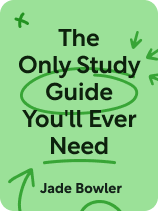

This article is an excerpt from the Shortform book guide to "The Only Study Guide You'll Ever Need" by Jade Bowler. Shortform has the world's best summaries and analyses of books you should be reading.
Like this article? Sign up for a free trial here.
How does the brain learn best? How does the brain process information?
The Only Study Guide You’ll Ever Need by Jade Bowler explores four ideas that explain how your brain learns best. She uses the acronym “SAAD” to represent these ideas.
Keep reading to learn how the brain learns fast and efficiently.
Idea #1: Engage Repeatedly
How does your brain learn best? First, your brain remembers information best by engaging with it repeatedly over time—this popular concept is called “spaced repetition.” Bowler explains that the more time that passes after you learn something, the more information you forget. The key to overcoming this is to review the information again right before you’re about to forget it. Keep doing this each time you feel you’re close to forgetting the material. Each time you review it, you’ll be able to remember the information for longer, eventually fully ingraining it into your long-term memory.
(Shortform note: Bowler argues that spaced repetition is the best way to memorize and retain information long-term, and numerous studies support her claim. Scientists began studying the effect of spacing material and tests on memory recall in 1939, and by 1989, a literature review emerged showing overwhelming evidence that spaced repetition boosts learning. Later studies from accredited universities and institutions showed that spaced repetition is effective for learners of all ages and may work by causing significant electrical activity in the right frontal part of the brain.)
Idea #2: Build Connections
Second, your brain remembers new information better by connecting it to concepts it already knows. (Bowler calls this “association.”) For example, imagine you have to memorize the purpose of white blood cells—to fight diseases in our body. It might be hard to remember this information alongside all the other information on an exam. However, if you’re able to connect the purpose of white blood cells to the purpose of a concept you’re already familiar with, like the mythological “white knight” who comes to someone’s aid, it’ll be easier to remember.
(Shortform note: What if you’re learning about a completely new, esoteric topic and can’t think of an existing frame of reference to connect the information to? In A Mind for Numbers, Barbara Oakley suggests a few other ways to make information more memorable. You could move your body while reviewing the information, since we’re more likely to remember things that involve movement. Or, you could try to make the information humorous in some way, as we’re more likely to remember things that make us laugh.)
Idea #3: Engage Deeply
Third, your brain remembers and understands information best when it’s forced to engage deeply. (Bowler refers to this technique as “active recall.”) This is because deep engagement with information strengthens neural pathways in our brains that help us recall that information. Simply viewing study material isn’t enough to strengthen these pathways. Instead, Bowler says we need to think hard about and apply information. For example, asking yourself to define a term and use it properly in a sentence is a more effective way to remember and understand it than simply reading the word and its definition repeatedly.
(Shortform note: Experts agree with Bowler’s point here and elaborate that one of the best ways to engage deeply with a concept and increase understanding is to teach, or pretend to teach, it to others. This psychological phenomenon, called the protégé effect, occurs because teaching information to another person boosts your metacognitive processes. You’re required to test your own knowledge and use it to inform others, making you more aware of your level of understanding and which areas you might need to improve in.)
Idea #4: Make It Hard
Fourth, doing things that are hard will improve your ability and understanding the most. (Bowler refers to this idea as “desired difficulty.”) Bowler explains that our brains prefer doing things that we’re good at or find easy over things that we struggle with. Doing easy things makes us feel like we’re being productive, but the brain is just tricking us into avoiding the hard work that will actually improve our abilities. So instead of spending time on easy tasks, seek out material and techniques that cause you to work harder—this is how you’ll actually increase your abilities
(Shortform note: In Peak, Anders Ericsson agrees that easy tasks don’t do much to improve our abilities—practice must be difficult and push you out of your comfort zone if it’s going to help you improve. This is the fourth tenet of his “purposeful practice” framework, which explains how to make practice (like studying) the most productive. In addition to making the practice hard, he recommends having a specific goal for improvement, giving the practice your undivided attention, and seeking feedback from others.)

———End of Preview———
Like what you just read? Read the rest of the world's best book summary and analysis of Jade Bowler's "The Only Study Guide You'll Ever Need" at Shortform.
Here's what you'll find in our full The Only Study Guide You'll Ever Need summary:
- Why school doesn't have to be chronically overwhelming
- How students can manage their mindset, study habits, and time
- Science-backed time management and study techniques to help you ace your exams






